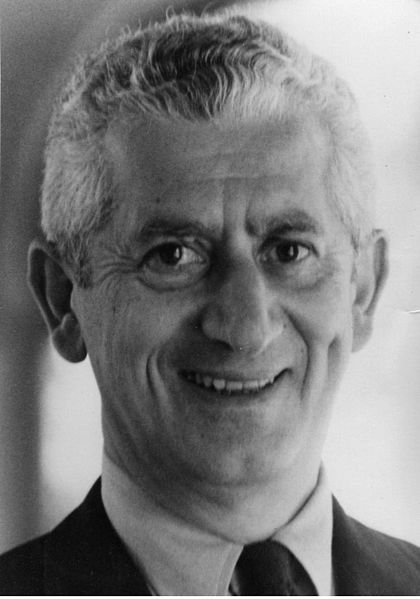Educators have typically used Bloom’s taxonomy to inform or guide the development of assessments (tests and other evaluations of student learning), curriculum (units, lessons, projects, and other learning activities), and instructional methods such as questioning strategies. (Bloom’s Taxonomy, 2014)
Biography
Benjamin Samuel Bloom, one of the greatest minds to influence the field of education, was born on February 21, 1913 in Lansford, Pennsylvania. As a young man, he was already an avid reader and curious researcher. Bloom received both a bachelor’s and master’s degree from Pennsylvania State University in 1935. He went on to earn a doctorate’s degree from the University of Chicago in 1942, where he acted as first a staff member of the Board of Examinations (1940-43), then a University Examiner (1943-59), as well as an instructor in the Department of Education, beginning in 1944. In 1970, Bloom was honored with becoming a Charles H. Swift Distinguished Professor at the University of Chicago.
Bloom’s most recognized and highly regarded initial work spawned from his collaboration with his mentor and fellow examiner Ralph W. Tyler and came to be known as Bloom’s Taxonomy. These ideas are highlighted in his third publication, Taxonomy of Educational Objectives: Handbook I, The Cognitive Domain. He later wrote a second handbook for the taxonomy in 1964, which focuses on the affective domain. Bloom’s research in early childhood education, published in his 1964 Stability and Change in Human Characteristics sparked widespread interest in children and learning and eventually and directly led to the formation of the Head Start program in America. In all, Bloom wrote or collaborated on eighteen publications from 1948-1993.
Aside from his scholarly contributions to the field of education, Benjamin Bloom was an international activist and educational consultant. In 1957, he traveled to India to conduct workshops on evaluation, which led to great changes in the Indian educational system. He helped create the International Association for the Evaluation of Educational Achievement, the IEA, and organized the International Seminar for Advanced Training in Curriculum Development. He developed the Measurement, Evaluation, and Statistical Analysis (MESA) program at eh University of Chicago. He was chairman of both the research and development committees of the College Entrance Examination Board and the president of the American Educational Research Association.
Introduction
One of the basic questions facing educators has always been “Where do we begin in seeking to improve human thinking?” (Houghton, 2004). Fortunately, we do not have to begin from scratch in searching for answers to this complicated question. The Communities Resolving Our Problems (CROP) recommends, “One place to begin is in defining the nature of thinking.
Before we can make it better, we need to know more of what it is” (Houghton, 2004). Benjamin S. Bloom extensively contemplated the nature of thinking, eventually authoring or co-authoring 18 books. According to a biography of Bloom, written by former student Elliot W Eisner, “It was clear that he was in love with the process of finding out, and finding out is what I think he did best. One of Bloom’s great talents was having a nose for what is significant” (2002).
Although it received little attention when first published, Bloom’s Taxonomy has since been translated into 22 languages and is one of the most widely applied and most often cited references in education. (Anderson & Sosniak, 1994, preface), (Houghton, 2004), (Krathwohl, 2002), (oz-TeacherNet, 2001). As of this writing, three other chapters in this e-book make reference to Bloom’s Taxonomy, yet another testament to its relevance.
History
In 1780, Abigail Adams stated, “Learning is not attained by chance; it must be sought for with ardor and attended to with diligence” (quotationspage.com, 2005).
- Learning, teaching, identifying educational goals, and thinking are all complicated concepts interwoven in an intricate web.
-
Discussions during the 1948 Convention of the American Psychological Association led Bloom to spearhead a group of educators who eventually undertook the ambitious task of classifying educational goals and objectives. Their intent was to develop a method of classification for thinking behaviors that were believed to be important in the processes of learning. Eventually, this framework became a taxonomy of three domains:
Bloom was arduous, diligent, and patient while seeking to demystify these concepts and untangle this web. He made “the improvement of student learning” (Bloom 1971, Preface) the central focus of his life’s work.
Discussions during the 1948 Convention of the American Psychological Association led Bloom to spearhead a group of educators who eventually undertook the ambitious task of classifying educational goals and objectives. Their intent was to develop a method of classification for thinking behaviors that were believed to be important in the processes of learning. Eventually, this framework became a taxonomy of three domains:
Note
- The cognitive – knowledge based domain, consisting of six levels
- The affective – attitudinal based domain, consisting of five levels, and
- The psychomotor – skills based domain, consisting of six levels.
In 1956, eight years after the group first began, work on the cognitive domain was completed and a handbook commonly referred to as “Bloom’s Taxonomy” was published. This chapter focuses its attention on the cognitive domain.
While Bloom pushed for the use of the term “taxonomy,” others in the group resisted because of the unfamiliarity of the term within educational circles.
Eventually, Bloom prevailed, forever linking his name and the term. The small volume intended for university examiners “has been transformed into a basic reference for all educators worldwide. Unexpectedly, it has been used by curriculum planners, administrators, researchers, and classroom teachers at all levels of education” (Anderson & Sosniak, 1994, p. 1). While it should be noted that other educational taxonomies and hierarchical systems have been developed, it is Bloom’s Taxonomy which remains, even after nearly fifty years, the de facto standard


